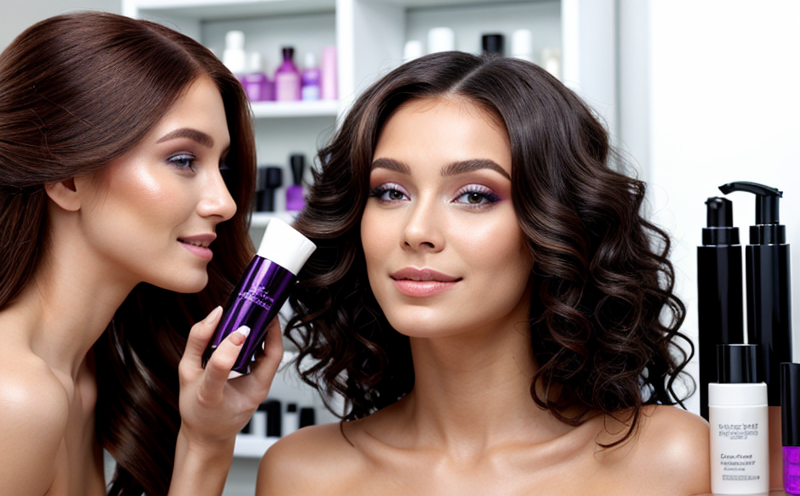Heat Protection Testing of Hair Sprays
The heat protection testing of hair sprays is a crucial process in ensuring that these products can withstand high temperatures encountered during use without compromising their performance or causing damage to the user’s hair. This service is particularly important for brands aiming to meet consumer expectations and regulatory standards, especially when targeting regions with hot climates where users frequently apply hair spray under heat stress.
When testing for heat protection, manufacturers must consider a range of factors that influence how well a product can protect against thermal damage. These include the alcohol content in the formula, the type of polymers used, and the overall formulation balance. Testing typically involves subjecting samples to various temperature conditions to assess their resistance levels.
One key aspect is the measurement of heat deformation points (HDP), which determines at what temperature a sample begins to show signs of damage due to exposure to high temperatures. This value provides valuable insights into the product’s ability to retain its integrity under extreme conditions. Another important metric is the degree of adhesion loss, indicating how much the formulation holds together after being subjected to heat.
For accurate testing, it's essential to follow internationally recognized standards such as ISO 20958-1 & 2 for cosmetic products, which outline procedures for determining the resistance to thermal damage. These guidelines ensure consistency across different laboratories and help maintain high-quality control measures throughout the industry.
The testing process itself involves placing samples in specialized ovens designed to simulate real-world usage scenarios, ensuring that results are reflective of actual performance conditions faced by end-users. Post-testing analysis focuses on evaluating changes in viscosity, color stability, and overall consistency compared to baseline measurements taken before exposure.
Understanding the environmental impact is also critical when developing heat protection solutions for hair sprays. By optimizing formulas through rigorous testing, companies can minimize waste generation while enhancing product efficacy. Additionally, selecting eco-friendly ingredients supports sustainable practices within the cosmetic sector by reducing reliance on non-renewable resources and promoting safer disposal methods.
In summary, thorough heat protection testing plays a vital role in ensuring that hair sprays not only meet regulatory requirements but also provide reliable performance under diverse environmental conditions. Through careful experimentation and adherence to best practices outlined in recognized standards like ISO 20958-1 & 2, manufacturers can develop robust formulations capable of protecting users' locks from potential thermal damage.
Scope and Methodology
The scope of heat protection testing encompasses the evaluation of a hair spray’s ability to resist thermal stress without degradation. Specifically, this includes assessing parameters such as viscosity changes, adhesion strength retention, color stability, and overall integrity preservation during exposure to elevated temperatures.
To achieve accurate results, specimens undergo rigorous procedures using state-of-the-art equipment tailored for simulating authentic usage scenarios. Samples are placed inside controlled environments where temperature variations mimic those experienced by end-users, allowing researchers to observe any adverse effects on the product’s properties over time.
Once testing concludes, detailed reports outline findings, highlighting areas of improvement needed for enhancing heat resistance capabilities. Compliance with relevant international standards ensures that these assessments meet industry benchmarks and contribute positively towards maintaining consumer trust in cosmetic products.
Industry Applications
In the world of cosmetics, heat protection testing is indispensable for ensuring product safety and efficacy. By incorporating this service into their development processes, manufacturers can guarantee that their hair sprays not only perform optimally but also remain safe even when exposed to high temperatures.
This testing is particularly beneficial in climates where extreme weather conditions are common, making it essential for brands targeting such markets. For instance, companies operating in regions like the Middle East or Southern Europe often rely on robust heat protection features within their product lines to cater effectively to local consumer preferences and demands.
Moreover, this service supports broader industry trends towards sustainability by encouraging the use of environmentally friendly materials that maintain stability under varying temperature ranges. Such practices align with growing consumer awareness regarding eco-friendly choices in personal care products.
Environmental and Sustainability Contributions
The environmental impact assessment associated with heat protection testing extends beyond immediate product performance to encompass long-term effects on resource consumption and waste generation. By optimizing formulations through comprehensive evaluation, manufacturers can reduce reliance on non-renewable resources while promoting safer disposal methods.
This approach fosters a more sustainable manufacturing process by minimizing carbon footprints throughout the supply chain lifecycle. Furthermore, adhering to stringent testing protocols helps ensure that products meet stringent environmental regulations globally, thereby fostering responsible business practices within the cosmetic sector.
Ultimately, integrating heat protection testing into R&D efforts contributes significantly towards achieving broader sustainability goals across industries. Through continuous improvement initiatives based on scientific data derived from these tests, companies can play active roles in preserving natural resources and promoting healthier lifestyles for consumers worldwide.





